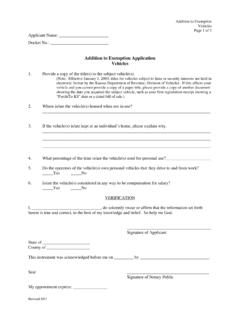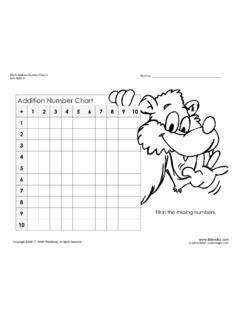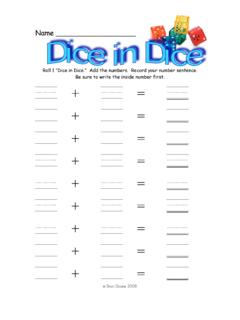Transcription of Georgia Standards of Excellence Curriculum …
1 These materials are for nonprofit educational purposes only. Any other use may constitute copyright infringement. Georgia Standards of Excellence Curriculum Frameworks GSE First Grade Unit 3: Operations and Algebraic Thinking Mathematics Georgia Department of Education Georgia Standards of Excellence Framework GSE Operations and Algebraic Thinking Unit 3 Mathematics GSE First Grade Unit 3: Operations and Algebraic Thinking Richard Woods, State School Superintendent July 2018 Page 2 of 102 All Rights Reserved Unit Three: Operations and Algebraic Thinking TABLE OF CONTENTS Overview.
2 3 Standards for Mathematical Practice ..4 Standards for Mathematical Content ..4 Big Ideas ..5 Essential Questions ..6 Concepts & Skills to Maintain ..6 Strategies for Teaching and Learning ..6 Selected Terms and Symbols ..8 FAL ..9 Number Writing in Page Citations ..11 Tasks ..12 Intervention Table ..15 1. Developing Meaning Using Story Problems: Result Unknown ..17 2. Lots of 3. What Numbers Can You Make ..30 4. Wheel Shop ..36 5. I Want Candy! ..45 6. Digging Dinosaurs ..54 7. Developing Meaning Using Story Problems: Change Unknown ..65 8. FAL ..72 9. Shape Pounds.
3 73 10. Fact Families to Ten ..79 11. Developing Meaning Using Story Problems: Initial Unknown ..85 12. Domino Fact Family ..90 13. Candy ..96 14. Culminating Task: Atlanta Zoo ..99 IF YOU HAVE NOT READ THE FIRST GRADE Curriculum OVERVIEW IN ITS ENTIRETY PRIOR TO USE OF THIS UNIT, PLEASE STOP AND CLICK HERE: Return to the use of this unit once you ve completed reading the Curriculum Overview. Thank you! Georgia Department of Education Georgia Standards of Excellence Framework GSE Operations and Algebraic Thinking Unit 3 Mathematics GSE First Grade Unit 3: Operations and Algebraic Thinking Richard Woods, State School Superintendent July 2018 Page 3 of 102 All Rights Reserved OVERVIEW In this unit, students will: Explore, understand, and apply the commutative and associative properties as strategies for solving addition problems.
4 Share, discuss, and compare strategies as a class. Connect counting on to solving subtraction problems. For the problem 15 7 = ? they think about the number they have to count on from 7 to get to 15. Work with sums and differences less than or equal to 20 using the numbers 0 to 20. Identify and then apply a pattern or structure in mathematics. For example, pose a string of addition and subtraction problems involving the same three numbers chosen from the numbers 0 to 20, such as 4 + 13 = 17 and 13 + 4 = 17. Analyze number patterns and create conjectures or guesses.
5 Choose other combinations of three numbers and explore to see if the patterns work for all numbers 0 to 20. Understand that addition and subtraction are related and that subtraction can be used to solve problems where the addend is unknown. Use the strategies of counting on and counting back to understand number relationships. Organize and record results using tallies and tables. Determine the initial and the change unknown. Students develop strategies for adding and subtracting whole numbers based on their prior work with small numbers. They use a variety of models, including discrete objects and length-based models ( , cubes connected to form lengths), to model add-to, take-from, put-together, take-apart, and compare situations.
6 They will use these models to develop meaning for the operations of addition and subtraction and to develop strategies to solve arithmetic problems with these operations. Prior to first grade students should recognize that any given group of objects (up to 10) can be separated into sub groups in multiple ways and remain equivalent in amount to the original group (Ex: A set of 6 cubes can be separated into a set of 2 cubes and a set of 4 cubes and remain 6 total cubes). Students understand connections between counting and addition and subtraction ( , adding two is the same as counting on two).
7 They use properties of addition to add whole numbers and to create and use increasingly sophisticated strategies based on these properties ( , making tens) to solve addition and subtraction problems within 20. By comparing a variety of solution strategies, children build their understanding of the relationship between addition and subtraction. (Ohio DOE) The standard expects teachers to use their understanding of the commutative and associative properties when teaching addition. The students are NOT expected to name or memorize these properties. First grade teachers are laying the foundation and building an understanding of these properties so that students can have formal discussions and utilize names of the properties in later grades.
8 Georgia Department of Education Georgia Standards of Excellence Framework GSE Operations and Algebraic Thinking Unit 3 Mathematics GSE First Grade Unit 3: Operations and Algebraic Thinking Richard Woods, State School Superintendent July 2018 Page 4 of 102 All Rights Reserved Standards FOR MATHEMATICAL PRACTICE The Standards for Mathematical Practice describe varieties of expertise that mathematics educators at all levels should seek to develop in their students. These practices rest on important processes and proficiencies with longstanding importance in mathematics education.
9 Students are expected to: 1. Make sense of problems and persevere in solving them. 2. Reason abstractly and quantitatively. 3. Construct viable arguments and critique the reasoning of others. 4. Model with mathematics. 5. Use appropriate tools strategically. 6. Attend to precision. 7. Look for and make use of structure. 8. Look for and express regularity in repeated reasoning. **Mathematical Practices 1 and 6 should be evident in EVERY lesson** Standards FOR MATHEMATICAL CONTENT Represent and solve problems involving addition and subtraction. Use addition and subtraction within 20 to solve word problems involving situations of adding to, taking from, putting together, taking apart, and comparing, with unknowns in all positions, , by using objects, drawings, and equations with a symbol for the unknown number to represent the Understand and apply properties of operations and the relationship between addition and subtraction.
10 Apply properties of operations as strategies to add and Examples: If 8 + 3 = 11 is known, then 3 + 8 = 11 is also known. (Commutative property of addition.) To add 2 + 6 + 4, the second two numbers can be added to make a ten, so 2 + 6 + 4 = 2 + 10 = 12. (Associative property of addition.) Understand subtraction as an unknown-addend problem. For example, subtract 10 8 by finding the number that makes 10 when added to 8. Add and subtract within 20 Relate counting to addition and subtraction ( , by counting on 2 to add 2). 1 See Glossary, Table 1 2 Students need not use formal terms for these properties.















